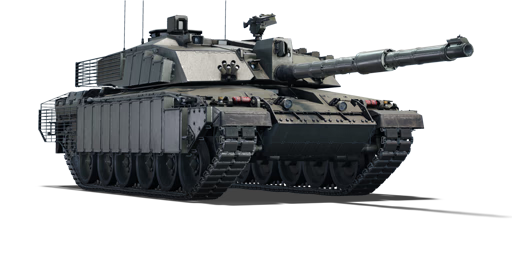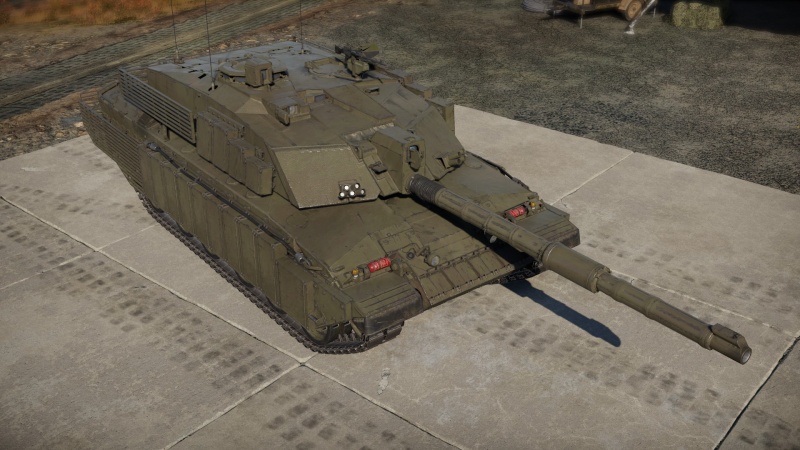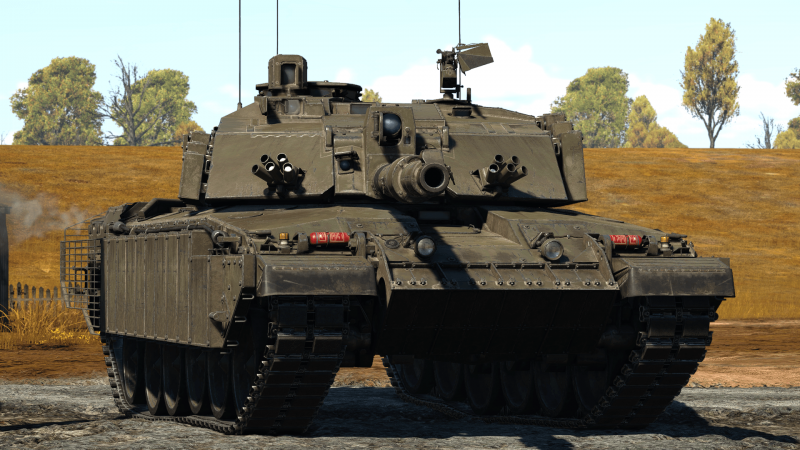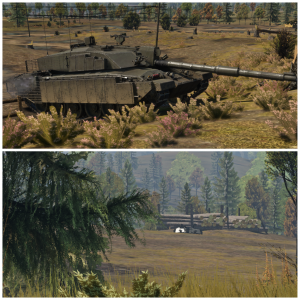Challenger 2 (2F)
| This page is about the British medium tank Challenger 2 (2F). For other versions, see Challenger 2 (Family). |
Contents
Description
The Tank, Combat, 120-mm Gun, Challenger 2 (Dorchester Level 2F) is a rank British medium tank with a battle rating of (AB), (RB), and (SB). It was introduced in Update "Starfighters".
General info
Survivability and armour
The Challenger 2 (2F) was created to give increased protection against shaped charges and as much is evident when evaluating the armour. While the internal composite armour remains the same from the previous variant, a large amount of external composite and ERA has been added to the hull front and sides as well as the turret sides. Additional slat armour has also been mounted to the sides and rear of the hull and turret.
With the only real change being the additional external armour, the same structural weak spots that exist on the Challenger 2 remain on the 2F. The large driver's port is an obvious target for enemy armour, which can penetrate it at almost any angle due to only RHA protection. Kinetic rounds aimed through the driver's port from the direct or near-direct front will often go straight through the tank, often taking several crew members, the cannon breech or the engine, occasionally resulting in a knocked out crew. Chemical rounds are less effective but fragments may set off the charges stored next to the driver, especially when fired at from above.
The gun mantlet is also a large weak spot, although kinetic rounds will be most effective, as chemical rounds will often only knock out the cannon breech or be blocked by the optics mounted at the top of the gun, which will allow the tank to pull back and repair provided it has the distance to do so. Kinetic rounds will often not fragment properly, going straight through the back of the turret, at max taking out two crew members due to the breech acting as a shield to the other side of the turret. Only when attacking from above will rounds have a significant chance of detonating ammunition due to the 2 stage system used by British tanks. Any ammunition stored in the turret will be warheads which are not able to be detonated.
As with the last variant and many other MBTs, the sides have no real kinetic protection, however the 2F has additional protection against chemical rounds. Most shots to the side of the front half of the turret have a high likelihood of taking out the cannon breech and a crew member, occasionally knocking out 2 or 3 crew. Any shots the the back half of the turret from the side will be ineffective due to the large amount of empty space. Aiming low on the tank's hull will give the best results for penetration and ammo detonation. Despite the additional ERA on the lower frontal plate, chemical rounds such as the German DM12A1 can still get through, and can get through the side mounted composite screens on a flat angle (0-25°).
| Armour | Front | Sides | Rear | Roof |
|---|---|---|---|---|
| Hull | 38-50 mm (56-83°) Upper Plate 70 mm (31-34°) Lower Glacis 60 mm (0-80°) Driver's Port |
25 mm (70°) Top 25 mm Middle 38 mm Bottom |
25 mm (32°) | 10-20 mm |
| Turret | 38 - 50 mm (56-82°) Turret Front 30 mm (3-82°) Gun Mantlet |
20-25 mm (8-10°) | 20 mm (18°) | 10-38 mm |
| Cupola | 8 mm (3-78°) | 8 mm (9-60°) | 8 mm (1-80°) | 44-60 mm |
Notes:
- Upper Frontal Plate has additional 10 mm external plate.
- Lower Frontal Plate has 25.4 mm external steel and ROMOR-A ERA. This is upgraded to a composite with NERA plate when mounting the Dorchester 2F upgrade, as detailed in the table above.
- Parts of the side and rear hull have mounted Slat Armour (50 mm Chemical Protection).
| Composite Armour | Front | Sides |
|---|---|---|
| Hull | Upper Kinetic: 420-1,000 mm Chemical: 700-950 mm Lower Kinetic: 100-400 mm Chemical: 350-570 mm With Dorchester 2F Modification |
Ext. Composite with NERA: Kinetic: 30 mm Chemical: 400 mm |
| Turret | Turret Cheeks Kinetic: 440-720 mm Chemical: 780-1,000 mm |
Internal Composite Kinetic: 190-740 mm Chemical: 300-1,000 mm Ext. Composite with NERA Kinetic: 30 mm Chemical: 400 mm |
Mobility
| Game Mode | Max Speed (km/h) | Weight (tons) | Engine power (horsepower) | Power-to-weight ratio (hp/ton) | ||||
|---|---|---|---|---|---|---|---|---|
| Forward | Reverse | Stock | AoA | Stock | Upgraded | Stock | Upgraded | |
| Arcade | 62.5 | 1.1 | 1,886 | 30.18 | __.__ | |||
| Realistic | 1,076 | 17.22 | __.__ | |||||
Modifications and economy
Armaments
Main armament
| 120 mm L30A1 | Turret rotation speed (°/s) | Reloading rate (seconds) | |||||||||||
|---|---|---|---|---|---|---|---|---|---|---|---|---|---|
| Mode | Capacity | Vertical | Horizontal | Stabilizer | Stock | Upgraded | Full | Expert | Aced | Stock | Full | Expert | Aced |
| Arcade | 50 | -10°/+20° | ±180° | Two-plane | 29.5 | 40.8 | 49.6 | 54.8 | 58.4 | 6.50 | 5.75 | 5.30 | 5.00 |
| Realistic | 18.4 | 21.7 | 26.4 | 29.1 | 31.0 | ||||||||
Ammunition
| Penetration statistics | |||||||
|---|---|---|---|---|---|---|---|
| Ammunition | Type of warhead |
Penetration @ 0° Angle of Attack (mm) | |||||
| 10 m | 100 m | 500 m | 1,000 m | 1,500 m | 2,000 m | ||
| Shot L23A1 | APFSDS | 396 | 394 | 387 | 376 | 367 | 357 |
| Shell L31A7 | HESH | 152 | 152 | 152 | 152 | 152 | 152 |
| L26 | APFSDS | 493 | 491 | 487 | 481 | 474 | 468 |
| L27A1 | APFSDS | 564 | 562 | 557 | 551 | 545 | 538 |
| Shell details | |||||||||
|---|---|---|---|---|---|---|---|---|---|
| Ammunition | Type of warhead |
Velocity (m/s) |
Projectile Mass (kg) |
Fuse delay (m) |
Fuse sensitivity (mm) |
Explosive Mass (TNT equivalent) (g) |
Ricochet | ||
| 0% | 50% | 100% | |||||||
| Shot L23A1 | APFSDS | 1,535 | 3.89 | N/A | N/A | N/A | 78° | 80° | 81° |
| Shell L31A7 | HESH | 670 | 17.1 | 0.1 | 4 | 6,560 | 73° | 77° | 80° |
| L26 | APFSDS | 1,650 | 4.1 | N/A | N/A | N/A | 78° | 80° | 81° |
| L27A1 | APFSDS | 1,650 | 4.1 | N/A | N/A | N/A | 78° | 80° | 81° |
| Smoke shell characteristics | ||||||
|---|---|---|---|---|---|---|
| Ammunition | Velocity (m/s) |
Projectile Mass (kg) |
Screen radius (m) |
Screen deploy time (s) |
Screen hold time (s) |
Explosive Mass (TNT equivalent) (g) |
| L34 | 670 | 17.1 | 20 | 5 | 25 | 50 |
Ammo racks
| Full ammo |
Ammo part |
1st rack empty |
2nd rack empty |
3rd rack empty |
4th rack empty |
5th rack empty |
6th rack empty |
7th rack empty |
8th rack empty |
9th rack empty |
10th rack empty |
11th rack empty |
Visual discrepancy |
|---|---|---|---|---|---|---|---|---|---|---|---|---|---|
| 50 | Projectiles Propellants |
44 (+6) 45 (+5) |
39 (+11) 39 (+11) |
32 (+18) 30 (+20) |
30 (+20) 22 (+28) |
28 (+22) 13 (+37) |
25 (+25) 5 (+45) |
22 (+28) 1 (+49) |
14 (+36) |
5 (+45) |
4 (+46) |
1 (+49) |
No |
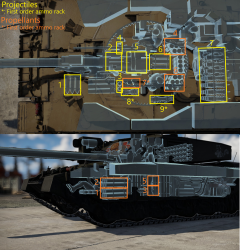
- Projectile racks 10 and 11, and propellant rack 7, are first-stage ammo racks
- Hull front empty: 22 (+28)
Machine guns
| 7.62 mm L37A2 | ||||
|---|---|---|---|---|
| Mount | Capacity (Belt) | Fire rate | Vertical | Horizontal |
| Pintle | 1,700 (100) | 650 | -10°/+50° | ±180° |
| 7.62 mm L94A1 | ||||
|---|---|---|---|---|
| Mount | Capacity (Belt) | Fire rate | Vertical | Horizontal |
| Coaxial | 2,300 (2,000) | 600 | N/A | N/A |
Usage in battles
In many ways, the Challenger (2F) plays the same as the precursor Challenger 2. This is because the original armour from the base Challenger 2 chassis remains unchanged, the same occurs with the powerplant. However, it distinguishes with an increase in the ability to brawl, mainly because of the optional Dorchester armour package. The 2F can more confidently find itself brawling alongside its teammates. Though players should be wary of the adversaries they are facing to decide which way of engagement is safer, depending on the map or the circumstances of the battle.
Protecting the Challenger
Ideally, Challenger 2 needs distance to operate to its full potential as a support tank sniping from very afar. This is beneficial for 3 main reasons:
- Obscure major weak spots on frontal armour (Driver position and gun mantlet)
- Protect the side armour from faster tanks capable of flanking
- Increase the effectiveness of the armour against enemy rounds
As expected, the tank excels at sniping as it has access to its Depleted Uranium round, the L27A1. It will be enough to knock out most enemy tanks, even at large distances. The combined use of the laser range finder and this round will be very effective during sniping. Smoke rounds are readily available for more supporting roles. Some moments will be more appropriate to use the smoke shells, as when capturing a point, interrupting an enemy sniper, or covering allied tanks while they advance; perfect for those who desire a more teamplayer gameplay.
Apart from distance, another key aspect in the gameplay of the Challenger 2 is the smart terrain placing and hull-down tactics. The nearly-unbeatable turret cheeks of the Challenger 2 are one of its specialties, therefore is greatly rewarding to enhance these protection levels even more with the gun depression levels; in a way echoing the older British MBTs as the Chieftains and Challenger Mk.1
The best way to use this strong turret protection is by choosing uneven terrain, where the lower frontal plate remains hidden from the enemy light of sight. Usually, on slopes, small rocks, impact craters or even destroyed enemy tanks. Most maps will offer some degree of elevations or slopes in which the Challenger 2 can lay down to snipe. This hull-down can be mixed with shoot-and-scoot tactics and sustained throughout the entire match, if done correctly this is one of the best ways of fighting.
Unfortunately, this playstyle comes with the hindrance of putting the Challenger 2 in exposed positions against enemy aircraft and helicopters, therefore is very important to relocate and keep a situational awareness, even if the tank is not in the core of the fight. Luckily, the Challenger can now more easily resist missiles from helicopters which one can expect to happen in open areas that lend to sniping. This is possible provided the missile does not hit the roof, so if a player sees a missile approaching, release smoke grenades and aim the turret towards the missile. The slat armour on the back of the tank is very effective against chemical rounds, including missiles, which can be the difference between living and being knocked out. Once hit, however, it will fall off and therefore players should attempt to avoid exposing their rear more-so where slat armour has been destroyed.
Urban maps
Brawling with the Challenger is now more plausible because of the 2F armour pack, although is not recommended to brawl in every scenario. Since the tank is heavier, taller and with more weak spots than many tanks in close ranges. Especially against enemies such as the T-90A or T-72B3. Both of these Soviet tanks are similar in speed to the Challenger, but their weak spots in frontal armour are harder to pinpoint than those on the Challenger. The brawling also creates an unsustainable situation against relentless adversaries such as the Leopards, T-80s or other various light tanks. Whenever possible, these fast vehicles will flank the Challenger 2. If CQB cannot be avoided, slight angling should be used to counter rounds. Players should attempt to draw attention to their turret or bait shots onto the Challenger 2s impenetrable turret cheeks, any experienced enemy player will quickly target the gun mantlet or driver's hatch. Challenger players should never attempt to endure in brawling with tanks as a Leopard 2A6 or Ariete, these tanks bring powerful rounds capable of nullifying any armour advantage of the Challenger on close ranges.
Anticipation, ambushing and camping tactics are important while in urban areas (guarding roads, crossroads or bridges). Moving up, taking a position, and waiting to see tanks or hear approaching engines is a viable strategy. Especially when going against Russian or American tanks, as their turbine engines give off that characteristic rotary whine.
During the early module research, the urban engagements can be done with some level of success, once the laser rangefinder, 2F armour pack and the L27A1 round has been researched, the full sniping potential of the Challenger 2 will be unleashed.
Pros and cons
Pros:
- Effective side-ERA against air-to-ground missiles
- Fast reload, particularly for a 120 mm (5 seconds aced)
- Sights with high zoom, 2nd generation thermals and a wide FOV
- High reverse of -40 km/h
- The L30A1 120 mm gun is incredibly accurate, even at long range
- Turret cheeks are invulnerable to all HEAT-FS and APFSDS, including the dreaded DM53 shell
Cons:
- Vulnerable commander's hatch and cannon breech
- Accessible weak spots, especially the gun mantlet
- Dorchester 2F only marginally increases LFP armour against APFSDS
- Dorchester 2F adds 1,100 kg of weight to an already sluggish tank
- No CITV (Commander Independent Thermal Viewer)
- L27A1 has low penetration compared to other top rank NATO ammunition
History
The Challenger 2F or CR2 TES is an upgraded version of the Challenger 2, featuring the upgrade kit known as TES (Theatre Entry Standard) and nicknamed 'Megatron'. The upgrade protection kit saw several adjustments over the years until the present time.
These modifications were ordered by the MOD, as part of the numerous updates inside the Challenger 2's LEP (Life Extension Programme) to increase the operability, lethality and protection of the 1998 design until 2025, or until a new British MBT design is available. The TES aims to increase the protection levels against the operational threats of the British Army such as the IEDs, hollow charges or Tandem charges - common threats during suburban deployments.
MCS
The Challenger 2 was covered with an MCS (Mobile Camouflage System) all around the tank, reducing the heat signature and keeping the vehicle almost indistinguishable from Thermal imaging devices.
Bar armour
The slat or bar armour was added to the sides and the rear of the vehicle to increase the levels of protection against rocket-propelled grenades while not downgrading the mobility of the Challenger. The bar armour must disrupt any hollow charges from detonating; either by crushing it upon impact or damaging the warhead and the fuse through contact with the bars.
Dorchester 2F armour kit
Most previous NERA (Non-Explosive Reactive Armour) side plates have been reinforced with additional Dorchester armour plates, notably the lower frontal-glacis protection was drastically improved, with the addition of a large block of Dorchester armour; augmenting the protection in one of the most vulnerable areas for the Challenger 2. Furthermore, the sides of the turret also received external Dorchester armour packages, enhancing the protection of the crew inside the fighting compartment from possible side-attacks.
Remote controlled weapon systems (RCWS)
As an offensive upgrade, the TES received a new Remote controlled weapon systems (RCWS) over the loader's hatch ring, capable of assessing the battlefield and engaging light targets or infantry from within the vehicle. Previously, the operator had to open the hatch to fire the pintle-mounted L37A2 7.62mm GPMG machine gun.
The CR2 TES also received IED jammers near the left and right front fenders and ECM countermeasures antennas capable of detecting nearby Improvised Explosive Devices.
Media
- Skins
- Videos
See also
- Analogues in other nations
External links
Paste links to sources and external resources, such as:
- topic on the official game forum;
- other literature.
| Britain medium tanks | |
|---|---|
| Valentine | Valentine I · Valentine IX · Valentine XI |
| Cromwell | Cromwell I · Cromwell V · Cromwell V (RP-3) |
| Cromwell derivatives | Challenger · Avenger · Comet I · Comet I "Iron Duke IV" · Charioteer Mk VII |
| Centurion | Centurion Mk 1 · Centurion Mk.2 · Centurion Mk 3 · Centurion Mk.5 AVRE · Centurion Mk 10 · Centurion Action X · FV4202 |
| Vickers MBT | Vickers Mk.1 · Vickers Mk.3 · Vickers Mk.7 |
| Chieftain | Chieftain Mk 3 · Chieftain Mk 5 · Chieftain Mk 10 |
| Challenger 1 | Challenger Mk.2 · Challenger Mk.3 · Challenger DS |
| Challenger 2 | Challenger 2 · Challenger 2 (2F) · Challenger 2 TES · Challenger 2 OES · Challenger 2E · Challenger 2 Black Night |
| Challenger 3 | Challenger 3 TD |
| Australia | A.C.I · A.C.IV · Centurion Mk.5/1 |
| South Africa | Olifant Mk.1A · Olifant Mk.2 · TTD |
| India | Vijayanta · Bhishma TWMP |
| Israel | ▄Sho't Kal Dalet |
| Jordan | Khalid |
| Sweden | ▄Strv 81 (RB 52) |
| USA | Grant I · Sherman II · Sherman Firefly · Sherman IC "Trzyniec" |


